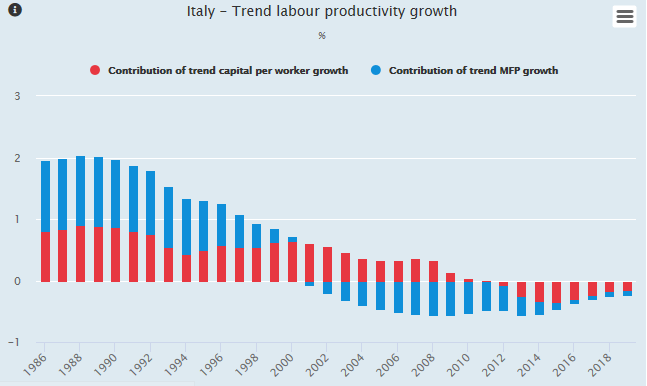Productivity Profile of Italy
 Organisations
Organisations
Ministry of Economy and Finance
 Selected Publications
Selected Publications
International Productivity Monitor: Productivity and Reallocation: Evidence from the Universe of Italian Firms (2017);
Banca d'Italia: Ownership, governance, management and firm performance: evidence from Italian firms (2022), Firm characteristics and potential output: a growth accounting approach (2021), Frontier and superstar firms in Italy (2019), Allocative Efficiency and Finance (2019), Credit Supply and Productivity Growth (2018), Productivity Growth in Italy: A Tale of Slow-Motion Change (2018);
Journal of Economic Geography: Does Weak Contract Enforcement Affect Firm Size? Evidence from the Neighbour's Court (2017);
ECB Forum on Central Banking: Productivity and Business Dynamics through the lens of COVID-19: the shock, risks and opportunities (2021);
OECD: Closing the Italian digital gap: The role of skills, intangibles and policies (2022), Productivity and human capital: The Italian case (2021), Blockchain for SMEs and entrepreneurs in Italy (2020), The Effect of Public Sector Efficiency on Firm-Level Productivity Growth: The Italian Case (2019).
 Data
Data
Click here to access our Compare-Your-Country tool and explore productivity data from the GFP member countries.

 Latest OECD Recommendations
Latest OECD Recommendations
- Reduce regulatory barriers to entering professional services, including replacing licensing systems with less distortionary certification schemes.
- Introduce a national productivity board to identify and communicate the costs and benefits of reforms, and build a national consensus.
- Ensure that the tax allowance for corporate equity is sufficiently predictable and generous to reduce the debt-equity bias.
- Improve oversight and accountability of elected officials and magistrates to improve the quality of policies and build public trust.
- Improve the effectiveness of public administration, including with regard to implementation, management, and prioritisation of public investments under the National Recovery and Resilience Programme.
- Implement the recent competition law reform.
- Open local public services to competition.
- Strengthen apprenticeships, vocational education, training courses, and lifelong learning. Develop a national framework on lifelong learning to help local authorities to align courses and practices with best practices.
Related Documents


